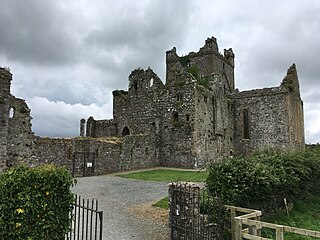
Robert Molesworth, 1st Viscount Molesworth was an Anglo-Irish politician, peer and writer.
Arthur Chichester, 2nd Earl of Donegall, PC (Ire) was an Anglo-Irish politician and peer.
Richard Butler, 1st Viscount Mountgarret was the son of Piers Butler, 8th Earl of Ormond and Lady Margaret Fitzgerald. He married his half first cousin Eleanor Butler, daughter of Theobald Butler of Polestown, the illegitimate brother of the 8th Earl of Ormond. He was created 1st Viscount Mountgarret in 1550.
Viscount Clanmalier, in the King's and Queen's County, was a title in the Peerage of Ireland. It was created on 22 December 1631 for Sir Terence O'Dempsey, Sheriff of Queen's County in 1591 who was knighted in 1599. He was made Baron of Phillipstown, in the Queen's County, at the same time, also in the Peerage of Ireland. His grandson, Lewis, the second Viscount, joined the Irish Rebellion of 1641 and was consequently attainted with his titles forfeited. However, in 1662 he was restored to a third of his former estates and presumably to his titles. His son, Maximilian, the third Viscount, was Governor of King's County. It is believed that Terence O'Dempsey, the youngest son of Maximilian fled Ireland with his cousin Sir John Byrne to England. The actual velum title document still exists.
Christopher Plunket, 2nd Earl of Fingall and 11th Baron Killeen was an Irish politician and soldier. In 1641 he negotiated with the rebels on behalf of the Old English of the Pale and pushed them to join the rebellion. He fought for the rebels at the siege of Drogheda. He joined the Confederates and fought in their Leinster army, notably at Dungan's Hill. When the Confederates fused into the Royalist Alliance, he fought under James Butler, 1st Duke of Ormond in the Battle of Rathmines where he was wounded and taken prisoner. He died of his wounds two weeks later in captivity at Dublin Castle.
General Robert Edward King, 1st Viscount Lorton, styled The Honourable from 1797 to 1800, was an Anglo-Irish peer and politician. He was notable for his strong support for anti-Catholic policies and his close association with the Orange Order.
Sir Christopher Nugent, 6th Baron Delvin (1544–1602) was an Irish nobleman and writer. He was arrested on suspicion of treason against Queen Elizabeth I of England, and died while in confinement before his trial had taken place.
Charles Stanley Monck, 1st Viscount Monck, was born in 1754 and died on 9 June 1802. He was the 1st son of Thomas Monck MP, by his wife, Judith Mason, daughter of Robert Mason, of Mason Brook.
Lettice FitzGerald, 1st Baroness Offaly was an Irish noblewoman and a member of the FitzGerald dynasty. Although she became heiress-general to the Earls of Kildare on the death of her father, the title instead went to the next FitzGerald male heir when her grandfather, the 11th Earl of Kildare, died in 1585. In 1620, she was created suo jure Baroness Offaly by King James I of England.
Nicholas Barnewall, 3rd Viscount Barnewall (1668–1725) was an Irish nobleman who fought for the Jacobites but afterwards sat in William's Irish Parliament. He was buried in a beautiful monument at Lusk.
Sir Lucas Dillon, also called Luke, was a leading Irish barrister and judge of the Elizabethan era who held the offices of Attorney General for Ireland and Chief Baron of the Irish Exchequer. He supported the Lord Deputy Henry Sidney in the cess controversy and the Lord Deputy John Perrot in the Desmond Rebellions. He was held in high regard by Queen Elizabeth, but was accused by his enemies of corruption and maladministration.
Richard Nugent, 2nd Earl of Westmeath was an Irish nobleman.
Hyacinth Richard Nugent, 2nd Baron Nugent of Riverston, born after 1684, died 5 March 1738.
Sir John Meade, 1st Baronet (1642–1707) was an Irish barrister, judge and politician. He was the first of the Meade Baronets of Balintubber, and an ancestor of the Earls of Clanwilliam. He was unusual among the lawyers of his time for his lack of ambition to become a judge of the High Court, despite being generally regarded as a barrister of "excellent parts (qualities)". In matters of religion, he seems to have been, by the standards of his time, a man of very tolerant views: although he was himself a Protestant, he damaged his career by marrying Elizabeth Butler, who was a Roman Catholic, as his third wife.
John Bathe (1536-1586) was an Irish lawyer and statesman of the sixteenth century. He held several important offices, including that of Attorney General for Ireland and Chancellor of the Exchequer of Ireland. He was a member of a prominent landowning family from County Dublin, and himself added to the family estates. His children included the Jesuit William Bathe, who was a noted musicologist.
Sir William Warren was an Irish landowner, statesman and soldier of the late sixteenth century. He is mainly remembered now for having facilitated the much-discussed marriage of Hugh O'Neill, Earl of Tyrone and his third wife Mabel Bagenal, which took place at Warren's home, Drumcondra Castle, in 1591.
Terence O'Dempsey, 1st Viscount Clanmalier was an Irish aristocrat.
Patrick Sarsfield was an Irish landowner and soldier of the seventeenth century noted for his role in the Irish Confederate Wars. He is best known as the father of Patrick Sarsfield, 1st Earl of Lucan, and is sometimes referred to as Patrick Sarsfield the Elder because of this.
Maximilian O'Dempsey, 3rd Viscount Clanmalier was an Irish aristocrat.

Sir Osborne Ichyngham or Echyngham was an English official and landowner in Ireland.

